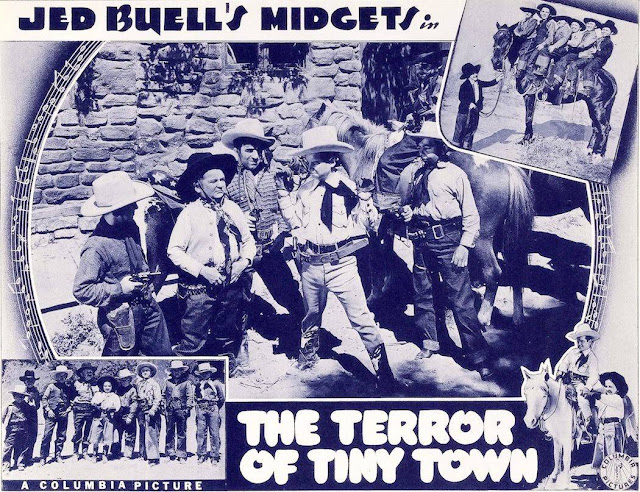Western Film WTF: The Terror of Tiny Town (1938)
A genuine oddity, "The Terror of Tiny Town" likely owed a lot of its notoriety to being included among "The Fifty Worst Films of All Time" by Michael Medved and two collaborators. I have long despised this book, which was an example of a slapped-together, sneering clickbait link before the web discovered such things.
The book is an almost random assemblage of films that the authors themselves did not like. While many are unmemorable, such as 1958's "Jet Attack," there are few that are really notably terrible — for some reason both "Lost Horizon" and "The Omen" wound up on this list. Quite a few of the so-called terrible films are actually quite interesting, such as "Valley of the Dolls" and the self-destructive anti-Western "The Last Movie," which I will wrote about at another time. It is no wonder Michael Medved eventually went on to be a right-wing crank; early on he demonstrated the sort of contemptuousness mixed with disgust that seem to lead both to right wing crankiness.
"Tiny Town" is probably the book's best example of "bad but interesting." The script, by Povery Row scribe Fred Myton, is unremarkable, but no worse than a million other cheapie oaters of the era. In fact, it contains an interesting twist, in that the film's villain has been stealing cattle from two competing ranchers and letting them take the blame for the theft, hoping to incite a range war and then pick up the pieces afterward.
Medved would probably never have noticed the film were it not for the casting: The whole film is cast with little people, here called, terribly, Jed Buell's Midgets. Buell was the director, and he was just borrowing a naming convention from vaudeville — about half the cast came from an established performing troupe called Singer's Midgets. But it's a horrible convention, both in that it suggests ownership and in the fact that midget is seen by many as being pejorative, coming, as it does from the name for a fly. While I know there are some little people who prefer the term, that is an in-group discussion for a group I am not part of, and so I will bow out and use the phrase "little people," which is more generally supported.
Now, the novelty of making a film entirely with little people is undeniable, especially when you place them on a pre-existing Western set that is too big for them (specifically Placeritos Ranch, later known as Melody Ranch and still in use; parts of "Django Unchained" were filmed there).
The film makes a few concessions to the size of its cast, including having them ride Shetland ponies, and doesn't generally make a fuss about the fact that everything else is too big for them, but it also doesn't generally use this as grist for comedy either. I can only only think of one shot which makes use of the size of the set, in which an actor simply walks under the double doors of a saloon rather than open them to enter.
And this is the thing that is baffling about the film. The whole setup seems to be that the film will take advantage of the comical possibilities of the actors' size, but it almost never does. There are some comical bits of business (or I should say "supposedly comical," as they are broad and unfunny), but almost never at the expense of the cast. Instead, it plows its way through its story as though it were just any other cowboy films, stopping occasionally for a musical interlude (including one very good cowboy song, "Down on the Sunset Trail").
There are a few moments of genuine absurdity. During a barbershop quartet sequence, a character glances over to a barrelhead and, for some reason, there is a penguin there. The musical numbers are often genuinely daffy — in one, the deepest notes are given to an actor with a baby face. But otherwise the film is unevenly paced, frequently feeling like it is both plodding and too much is happening too quickly. The last 10 minutes involves an attempted lynching, a fistfight that destroys the interior of a building, an arrest, an attempted assassination, and a massive explosion, and then closes with a song. That's a lot to have happen in 10 minutes, and yet it still feels like it is dragging.
A part of me imagines that it is possible that Jed Buell simply found it so comical to cast little people that he didn't feel like he needed to do anything else, which would be noxious, but I'm not sure that's the case. Buell also made a Western called "Harlem of the Prairie" featuring black singing cowboy Herb Jeffries, and it is likewise mostly just a Western, one of several African American westerns he would produce.
One just gets the sense that Buell found it interesting to cast non-traditional leads in cowboy films, and, seeing as little people, for the most part, are still mostly cast for comical effect or shock value, this seems unusual, even laudable.
I don't think it earns it a place in a list of 50 worst films ever made. In a just world, it would be considered as forgettable as any other mediocre Western Hollywood churned out.
We cannot ignore the novelty of the casting, though, and we certainly cannot ignore the penguin, and so the film becomes something else, neither good, nor bad, nor mediocre. It's sui generis, and how may Westerns can claim that?



Comments
Post a Comment